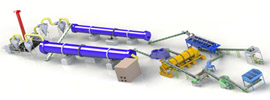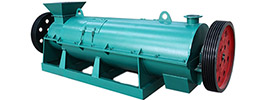The granulation of DAP fertilizer involves transforming raw diammonium phosphate materials into specific granular forms through physical processing technologies, aiming to enhance physical properties, usability, and nutrient release efficiency. Below is a detailed analysis from four perspectives: process principles, key equipment, technical parameters, and industry trends.
1. Process Principles: Neutralization Reaction and Granule Formation
The core of DAP granulation lies in the neutralization reaction between phosphoric acid and ammonia, generating DAP slurry that is subsequently shaped into granules. The workflow is as follows:
- Neutralization Reaction: Concentrated phosphoric acid (containing ~45% P₂O₅) reacts with liquid ammonia in a two-stage tubular reactor:
- Stage 1: Control the NH₃:H₃PO₄ molar ratio at 0.8–1.0 to produce monoammonium phosphate (MAP), with temperatures rising to 110–130°C.
- Stage 2: Additional liquid ammonia is introduced to adjust the molar ratio to 1.5–1.6, forming DAP-dominated slurry with a pH of 7.5–8.0 and a temperature of 130–150°C.
- Granule Formation: The ammonia-treated slurry (20–25% moisture content) is sprayed into a rotary drum granulator while incorporating recycled fines (DAP particles <2 mm, accounting for 30–40% of the feed). Granules are formed through coating, self-agglomeration, and adhesive bonding.
- Post-Treatment: Wet granules undergo drying (hot air at 300–350°C to reduce moisture to ≤2.0%), screening (2–5 mm granules ≥90%), and cooling (granule temperature <40°C) to yield finished products.
2. Key Equipment: The Central Role of Rotary Drum Granulators
Rotary drum granulators are the most widely used devices in DAP production, with their structure and parameters directly influencing granule quality:
- Equipment Structure:
- A cylindrical drum is installed at an incline and rotated by a drive system.
- The interior features slurry spray nozzles and ammonia distributors for uniform coating.
- A recycled fines system introduces fine DAP powder as nucleation sites to enhance granule uniformity.
- Process Parameters:
- Recycle Ratio: Typically maintained at 4.5–5.5:1. Excessive ratios increase system load and cause uneven granules, while insufficient ratios lead to caking.
- Slurry Spray Ratio: The ratio of tubular reactor slurry to pre-neutralized slurry is (45–55):(55–45), balancing moisture content and granulation efficiency.
- Granulation Temperature: Slurry temperatures of 130–150°C ensure optimal fluidity and reactivity.
3. Technical Parameters: Key Indicators of Granule Quality
DAP granules must meet the following standards:
- Nutrient Content: Total nitrogen (N) ≥18.0%, available phosphorus (P₂O₅) ≥46.0%, and total nutrients (N+P₂O₅) ≥64.0%.
- Physical Properties:
- Particle Size: 2–4 mm granules ≥90.0%, suitable for mechanical fertilization.
- Crushing Strength: Average particle strength ≥30.0 N/granule to prevent breakage during transportation.
- Water-Soluble Phosphorus: The ratio of water-soluble phosphorus to available phosphorus (WP₂O₅/AP₂O₅) ≥90.0%, ensuring rapid nutrient release.
- Appearance and Anti-Caking:
- Granules are round, translucent, and glossy, enhanced by internal coloring (dye additives) and external coating (anti-caking agents).
- External coatings delay nutrient release and reduce hygroscopicity (critical relative humidity: 75% at 25°C).
4. Industry Trends: Green Manufacturing and Efficient Production
- Eco-Friendly Granulation Technologies:
- Extrusion Granulation: Achieves flexible formulation adjustments via screw feeder modifications and die optimization, accommodating various additive requirements.
- Dry Granulation: Eliminates drying steps to reduce energy consumption and minimize dust emissions, aligning with carbon neutrality goals.
- Prilling Tower Granulation:
- Molten DAP is cooled naturally in a tall tower to form granules, saving drying energy and creating "void structures" for controlled release.
- Cost advantages include reductions of 30–40 RMB per ton, with superior granule roundness, hardness, and water solubility.
- Standardization and Intelligence:
- The 2024 Group Standard for Large Granular Compound Fertilizers systematically regulates granule size, hardness, and other parameters.
- Smart control systems monitor parameters like recycle ratios and slurry flow in real time, optimizing efficiency and quality.
5. Case Study: Innovations at Yuntianhua Group
Yuntianhua Group, China’s largest DAP producer, enhances competitiveness through:
- Resource Optimization: Leveraging Guizhou Kaiyang phosphate ore and Yichang petrochemical ammonia, reducing raw material costs by ~150 RMB per ton.
- Process Upgrades: Replacing traditional twin-shaft granulators with rotary drum models extends operational life and lowers maintenance costs.
- Product Enhancement: Internal coloring and external coating technologies improve granule appearance and moisture resistance, solidifying market leadership.
 Send us a Email
Send us a Email Wulong Industrial Cluster
Wulong Industrial Cluster Have any question?
Have any question?



















